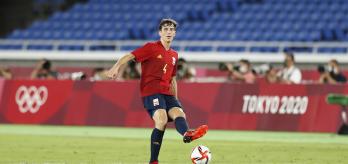Positional rotations
One standout build-up variation was provided by Korea Republic. The quarter-finalists often sought to play out from the back by forming a box comprising their two centre-backs and central-midfield pairing. These midfielders would pull out wide to temporarily play the role of the inside full-backs and Korea Republic’s number 8 (a central midfielder) would then drop into the space created by the two parting players to become the free man and play an integral role in progressing the play. Meanwhile, the Group B winners’ actual full-backs pushed high up the pitch to complete the set-up required for this high-energy, aggressive build-up variation.
A build-up diamond
Like Korea Republic, bronze medallists Mexico also positioned their full-backs high up the pitch when building up play. However, instead of forming a box to initiate the build-up, the Tricolor created a diamond formed by their goalkeeper, two centre-backs and defensive midfielder as they looked to play out from the back. The team’s other two central midfielders, who both operated in the traditional number-8 role, injected some dynamism into the build-up with their forward runs.
Against low- and mid-block opponents, the Mexicans were able to form their diamond and consequently progress play more quickly into the final third.
Adaptation is key
One noteworthy trend identified amongst the teams that progressed furthest in the tournament relates to their willingness to adapt their build-up play to suit the opposition’s press. This approach meant that these sides ended up adopting more than a single build-up variation. Brazil, Spain and Mexico were the biggest proponents of this blueprint. When the opposition’s press involved two strikers, these teams built the play up with three at the back, whilst if the opposition pressed with a single striker, two centre-backs were deployed in the build-up phase. This flexibility of approach afforded these teams numerical superiority in the first line, which allowed them to play out short. Spain’s solution when the opposition applied an aggressive press featuring three offensive players was for the two full-backs to drop deep to create a 4v3 scenario.
According to the positional aspect, Spain, Brazil and Mexico have been the teams that have been the clearest when it comes to adapting build-up principles according to the position of the opponent.
Brazil's fluid flexibility
Gold medallists Brazil were one of the most fluid sides when it came to adapting their build-up according to the opposition. When looking to play out from the back, the Canarinha would either set up with the goalkeeper, a three-man backline and two midfielders to link the play centrally, or with the goalkeeper, a two-man backline and a three-man midfield chain. In both instances, the full-backs pushed high up the pitch to help the attacking players pin the opposition’s defence back. Veteran full-back, Dani Alves, was indispensable to his team’s ability to alternate between these two variations. If the opposition set up with more than one striker, Alves would slot in as a centre-back to form a three-man backline, whilst when up against a lone striker, he would push up to make a three-man midfield chain. This level of flexibility was undoubtedly instrumental in Brazil’s triumph at the Men’s Olympic Football Tournament Tokyo 2020.









